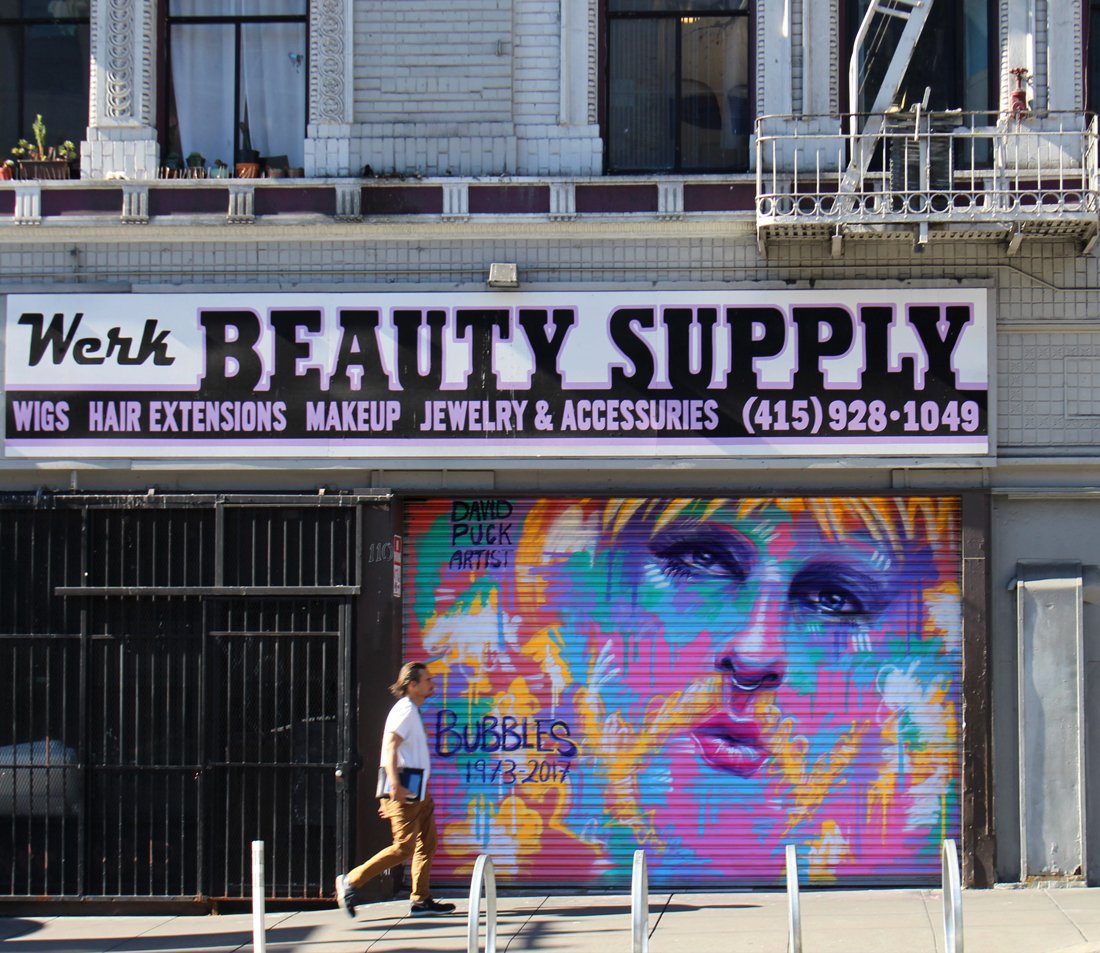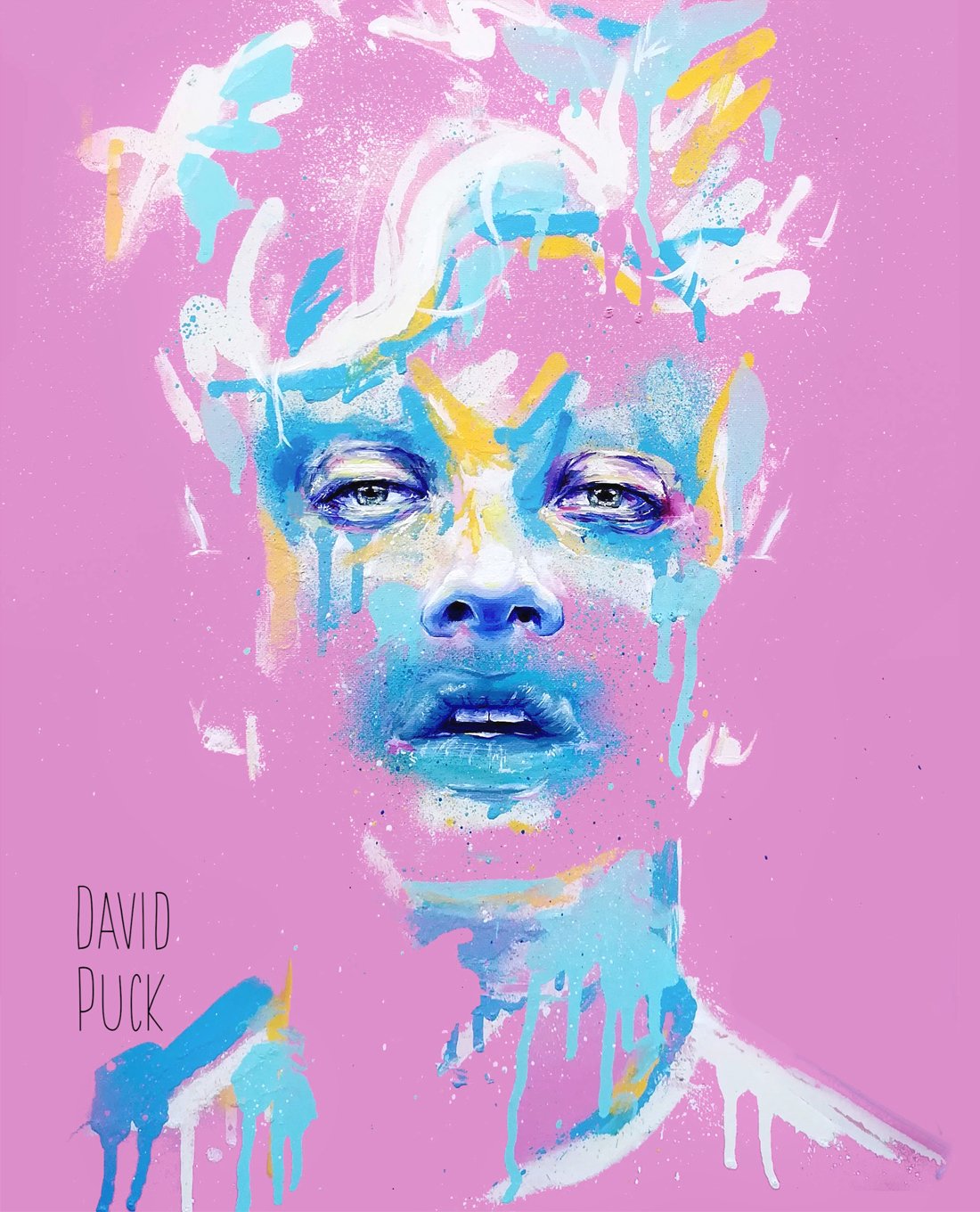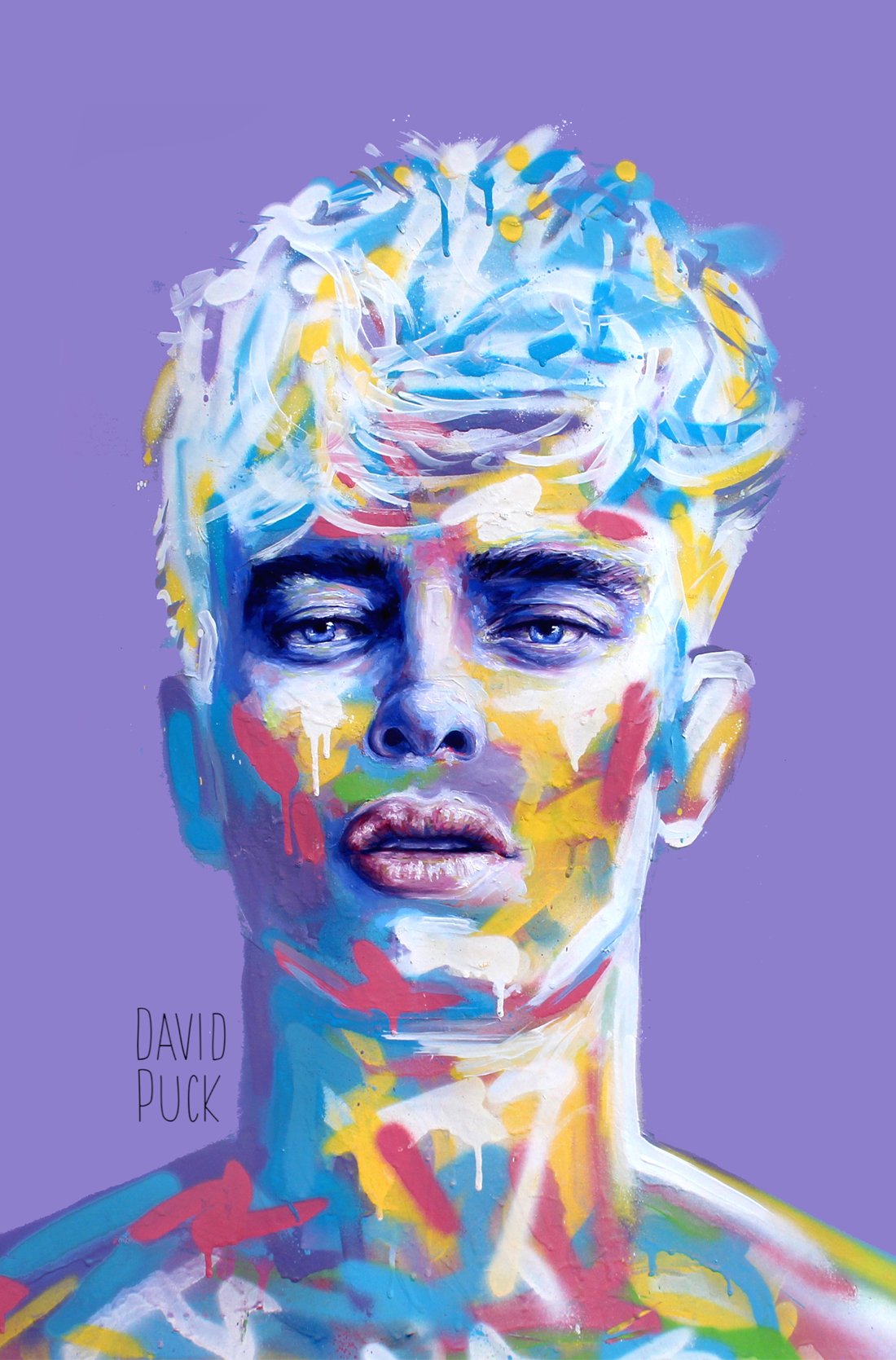
Through his incomparable painting style – in which a vibrant colorfulness enchants ones eyes, with an emphasis on highly detailed haunting facial expressions – David Puck uses a remarkable dejection in his many paintings dealing a striking impact to the observer. Furthermore, his characteristic use of painting techniques such as the use of drippy passages, often finds merging with the complex real-life feeling of his portraits.
YOSUNE: Vibrant, sharp, enchanting… your pieces have the ability to speak through their fine expressions, is there a common message that connects all of your creations?
DAVID: Thank you! Yes, my work is always an exploration of the blend of abstract and figurative, and there are two conceptual themes that are consistently present (either one or both). The first is queerness – queer experience, queer people, queer culture (such as drag), and the many ensuing discussions.
The second is mental health and various psychological phenomena – for example the overall image often speaks to the inevitable ups and downs of life, the poses to processes like melancholy, acceptance or freedom, and the style to chaos, fluidity and change. I’ll explain that more clearly later!
Y: How do you approach the process of creating a new piece?
D: There’s a few different stages. I’m inspired by people, so the subject themselves will first direct aspects of the piece. I have certain poses and expressions that I look for or create myself, following the themes I mentioned above like acceptance. I’ll experiment digitally on Gimp to try out ideas, its fast and easy to get quick visual references. Finally whilst painting I let the unpredictability and chaos of small-scale freehand spray paint somewhat take over, relinquishing the illusion of control and allowing the painting to take on a life of its own in a way. For murals its different, they are so large that control is once again at 100%, so I’m still exploring my mural style even more so than my canvas style.
In general I still feel in a very explorative stage of painting (and maybe I always will). So every new piece I approach I’m thinking a lot about my themes – particularly the relationship between abstraction and figuration – how I can represent the likeness, emotion and depth of a human, whilst also exploring more fantastical color, mark-making, abstraction and form. Its the push and pull of the two, again the ever-present contrasting opposites and balances of life.
Like many newer artists I’m obsessed with having a unique and recognizable style – so each new painting feels like a stepping stone towards that. People tell me I have it already so maybe my stepping stones are laid out in a circle haha.
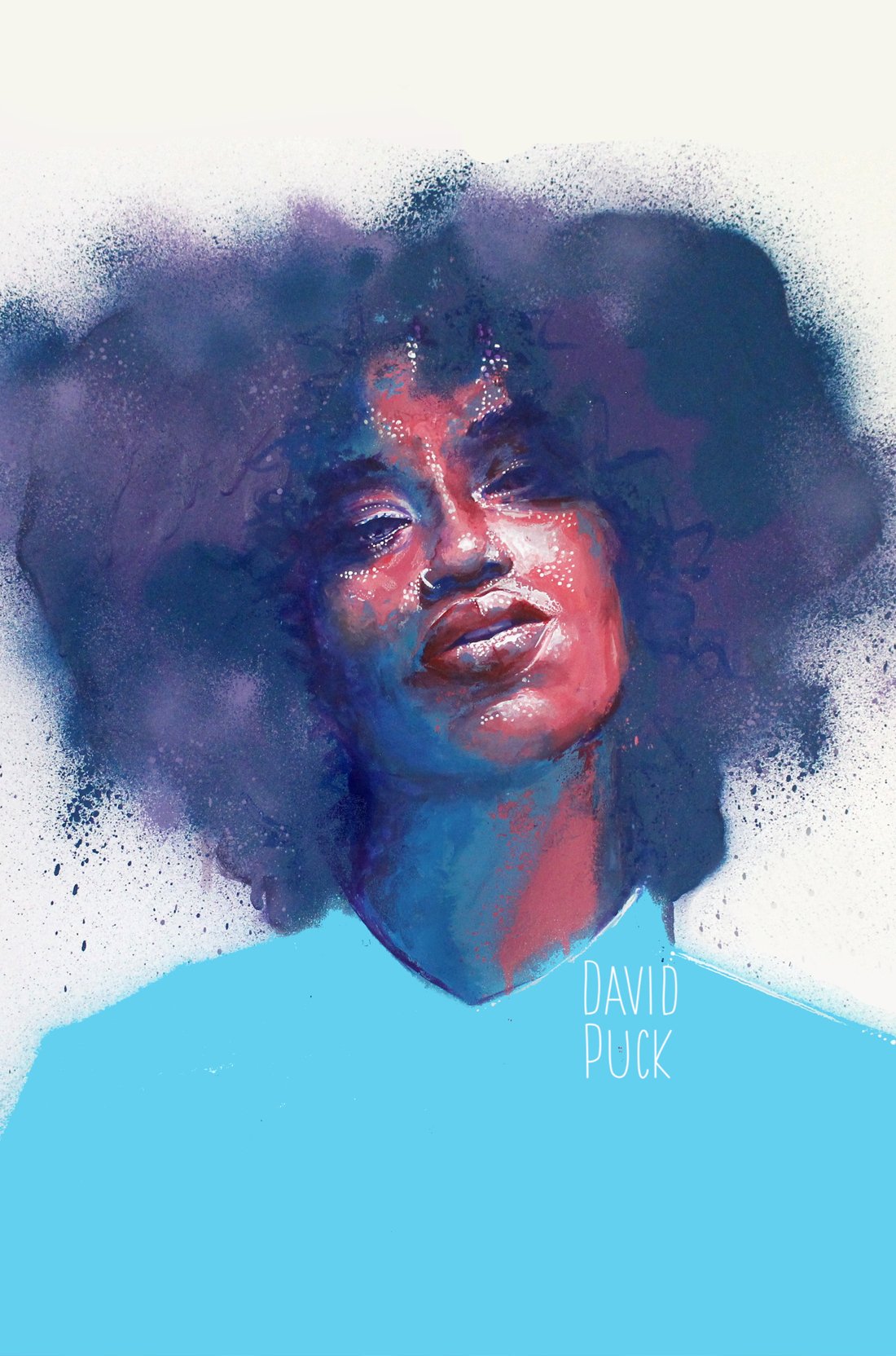
Y: As an artist and active queer community organizer, do you feel the representation of the scene is growing? What is your experience in regards to the resonance you receive as such?
D: Well of course it depends on where you are living, in Europe and USA for sure it has been growing for a long time and we seem to be at a particular zenith of queer issues being discussed, queer representation in public life, and queer culture being appreciated by the masses. But right now we also have a huge push-back by the [far] right – here in the USA its a very difficult time to be a minority, including queer. Everything in life goes in waves, but I do believe as a world those waves are overall moving towards acceptance, understanding and rebuttal of ignorance.
For murals I almost always paint drag performers – one because I think a 50ft tall drag queen is hilarous and amazing, and two because putting queer imagery in [straight] public space gets it outside of our echo chambers and forces us to find a way to co-exist together – you can’t avoid a 50ft tall drag queen!
Y: How did you come up with your unique painting style?
D: Oh so I do have a unique painting style! Stepping stones in a circle indeed haha.
I think its the same with everyone – that you just paint and paint and paint, and the more you paint the more you develop a sense of what you like and don’t like, what you want to explore or not. And that process of exploration and specification leads to something that seems unique to you. The key is to follow your own interests and desires, not to copy others or to make what you think you ought to make (whether its to sell or whatever other pressure).
For me, I love the immediacy and chaos of spray paint, and I love the flow stages of brush painting details, so I mix the two. I love queerness, drag, mental health, so that’s what I explore and paint thematically. I love bright colours, drips, the depth and craft of realistic detail, the contrast of minimalism and realism, abstraction and figuration, pastel colours – so that’s what I paint. And I’ve only ever been interested in painting people, I have never wanted to paint anything else. It didn’t come fast, and only now can I stop and identify what makes my painting my painting. So I think its also about not thinking and just letting the flow of the process direct you, the more paintings you make the more your own style will come out. My favourite paintings are the ones where I’m not consciously thinking about it – too much thinking and it can easily become contrived.
Y: To what extent is mental health a topic within your art?
D: Its something that I am always thinking about, every day of my life. I’m actually beginning the long process right now of becoming a mental health counsellor.
Within my paintings I know its not an immediately obvious theme, it needs a little placard hanging next to it. But its ever present in my mind.
As quickly explained above there’s a few different elements. I usually paint melancholic subjects because my visual style is very colourful, bright and pop – so the two together represent the contrasting opposites of life, the balance of life, there will always be a happy and a sad, a good and a bad, up and down, and a key aspect of mental health is acceptance of these inevitable waves. Not to avoid sadness, but know that it is a healthy part of a contented life.
The abstracted marks within the face represent processes within our minds – particularly fluidity and change, and the marks look that way, changing and fluid. Brain plasticity has found that our brains can change, and a key part of Cognitive Behavioural Therapy is that you can train your brain to think differently and therefore change your mental health. Its hugely powerful and goes against many peoples’ idea of self and life, where we crave permanence and solidity. Relatedly the abstraction represents the chaos of life, literally using the aforementioned chaos of spray paint, and how acceptance of the chaotic, non-sensical, irrational, randomness of life can actually set us free, because we stop needing things to be a certain way and just accept how they are.
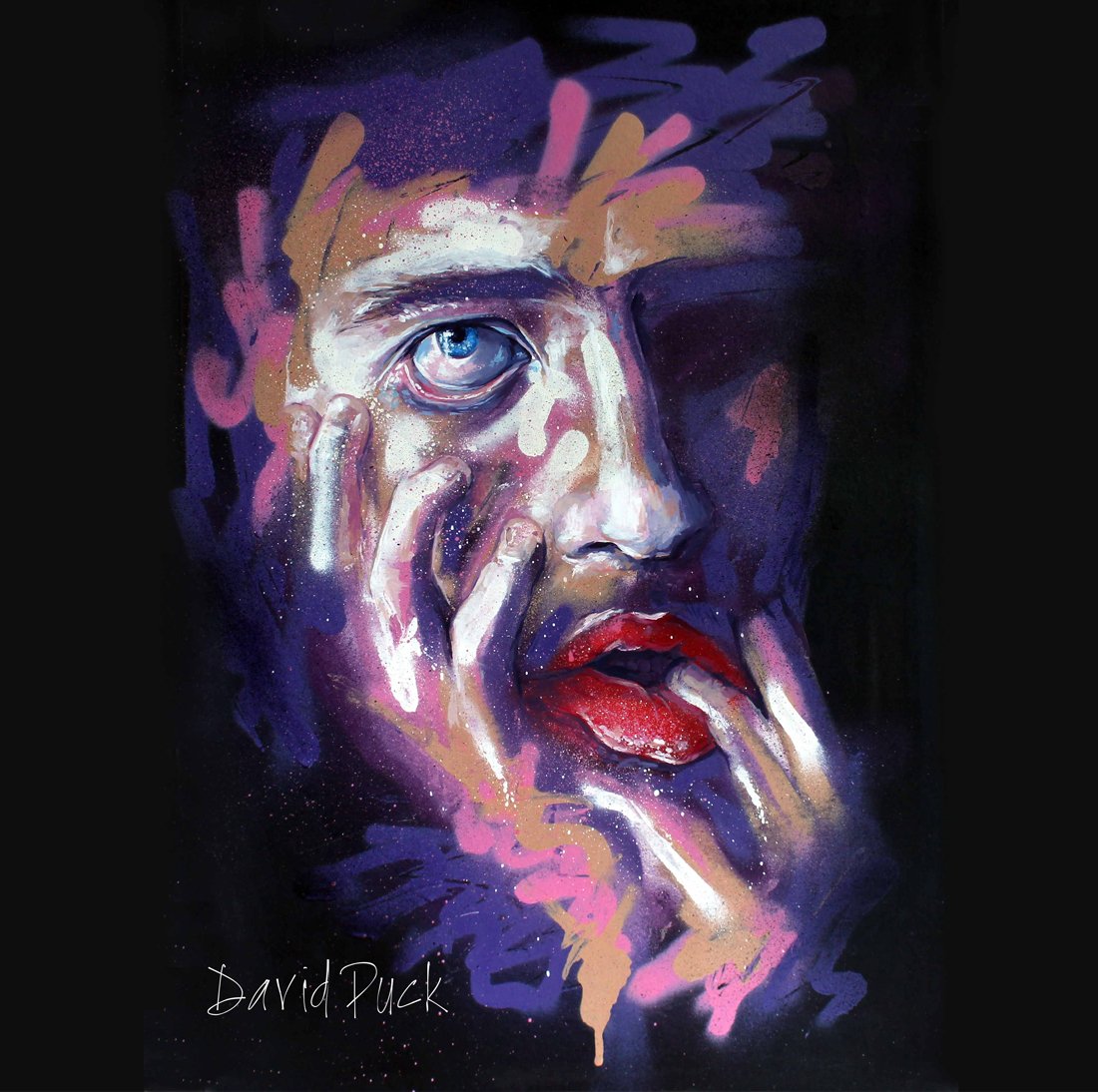
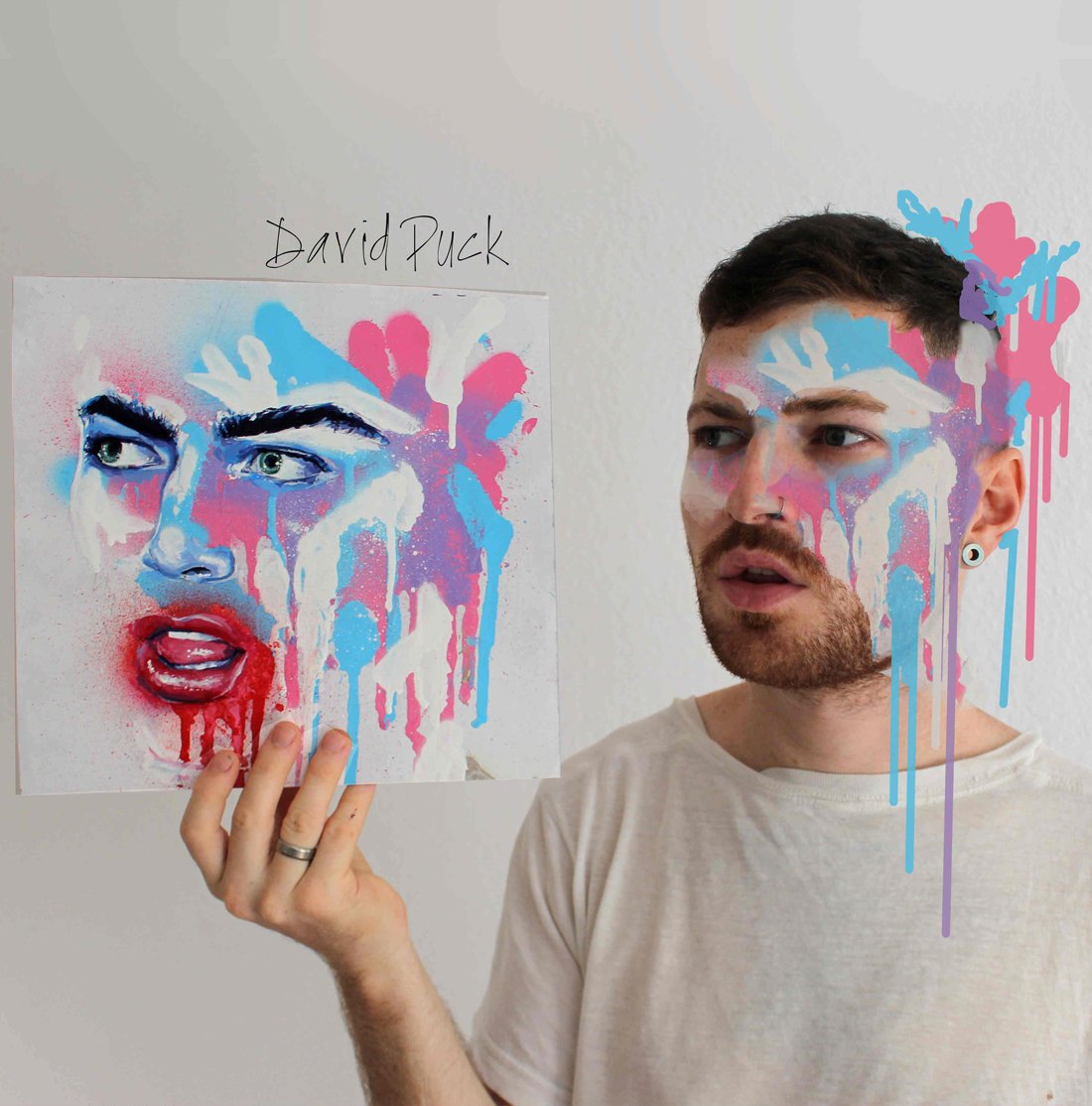
Y: When you encountered your passion towards mural paintings, how different was this technique to you compared to your other art?
D: In so many ways! Murals definitely taught me a lot about the purposeful construction and design of an image. I had relied on my ‘chaotic’ process for most of the impact and style of my canvas paintings, so with murals when I couldn’t do that, it forced me to have to purposefully create those marks instead of just letting them happen. Its a challenge and something I’m still exploring. But its made me think a lot more about what I am doing aesthetically, for the better.
And with murals you want to have a defined style even more so than with canvas, because people usually don’t notice your signature or crop it off in a photo, so you really want everyone to be able to look at it and know immediately that it is yours.
Similarly, murals are about public space and community engagement, so its made me think even more about what message and impact my painting has, what I am trying to communicate.
Creating something so BIG, it really puts a magnifying glass on the composition and worth of the image – it has to be good. If it looks good small it’ll look good big, but it has to look good. Otherwise you’ve got a permanent building sized reminder of an unworthy painting, you can’t throw the piece of paper away.
The bigger the murals go (my largest so far is about 40ftx40ft) it relativises my approach towards them – like now anything smaller than 40ft seems easy to make, because I know I’ve gone bigger, and especially a 30×40 inch canvas is tiny haha. It takes the pressure off. Murals usually have a time deadline too so its made me even faster at painting, and I already painted fast to begin with. So many ways! I think mural painting, or painting large in general, is very informative and educational.
Y: How did your geographic experiences shape your art and your person?
D: Again in so many ways! I don’t do simple answers apparently haha.
I grew up outside of a small rural city in England, so early on I wanted to travel and explore the world, to experience as much as possible in life. I yearned for freedom and like everyone I had a lot of issues to work out in myself. So at 19 I saved up money to solo backpack around Asia. Since then travel has been a huge part of my life and I’ve lived all over the world in many different places, and for now I’m based in California.
I think to try and keep it short-ish, it has greatly shaped my self and my world-view – to experience such breadth of culture and living, to constantly be in a position of ignorance, of everything being new and unknown, to basically be a child, to laugh at myself, to understand, relate to and accept people with which I at first seemingly have nothing in common. It creates understanding, empathy, taking yourself out of your own head and narrow understanding of how things are or ‘should be’, a constant respect and interest in other people. Relinquishing myself to the chaotic irrational beauty of life. My own mental health issues is what finally led me to leave England for good, not because England was causing it, but because I had to take agency of my own life and decide to become healthy, no matter what it took, and it felt like it needed a fresh start in a different place.
I think everything I’ve described above about my art and mental health has been hugely influenced by exploring the world, they are inextricably linked. And a huge plus of mural painting is that its allowing me to combine travel into my loves of drag and painting – I just painted queer murals in Mexico City last week, and this week I’m going to New York to paint there. So hopefully that can continue! Anyone with a wall and a flight budget hit me up 😉
